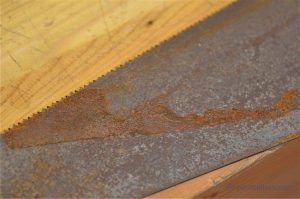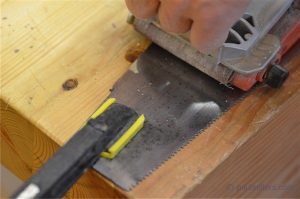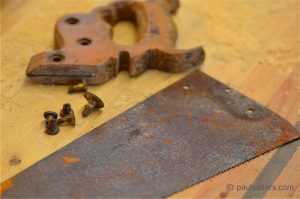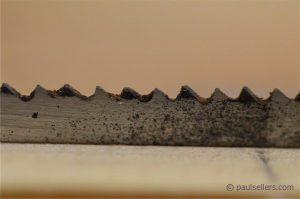Buying good tools cheap – Introducing the hand saws
For more information on saws, see our beginner site Common Woodworking.
I am going to risk it
I own a belt sander 4” wide. It’s made by Trend and it’s a piece of poor workmanship but the price was right because I could see how to improve it for what I wanted it for and this is where I take the risk. It’s really the risk of criticism. One is that people think I never use power equipment but I know more about power equipment than I do hand tools. I grew up with both from the start. The second risk is the criticism I will get when I tell you what I use it for the most. I restore rusted saw plates, many of them, before I begin reshaping teeth and sharpening and setting them. The plates are often badly encrusted with grunge, oil and rust. Some are too bad for hand work with sandpaper and yet underneath there is fine tool steel in the plate. By removing the handle I can use the wide belt sander to remove first the grunge and get down to steel and then the surface of the whole steel plate on both sides. As plates on the better saws are taper ground, using the belt sander enables me to ensure that the saw is indeed taper ground and if not I use the belt sander to effectively create a taper grind to the plate. I can even remove surface pitting caused by rust if a so desire, but the main thrust is to get the saw plate into a position for full restoration. I use a 120-grit belt for the first serious pass and then follow up with a 220 belt. The plate feels like silk and glides through the wood like a hot knife through butter.
Safety
Your safety is always your issue as well as but more than mine. If you don’t feel something is safe, don’t do it no matter what I or anyone else tells you. A couple of things you should be aware of. One, make sure that the plate is securely clamped to the bench top. The friction from the abrasive belt can grab the saw and send it flying like a frisbee. Secondly. remove the nylon woven dust bag. If sparks enter the bag they can combust sawdust and also melt the bag. When completed, check the belt sander to make certain there are no sparks seated in previously accumulated sawdust that might cause combustion. I have never had an incident using a belt sander for this purpose and the plates do look like new when done thoroughly. Take care that the belt sander doesn’t dig in as this is hard remove and unsightly. Start the machine off the saw and lower in a backward movement and then work in long forward stokes moving backwards and forwards in long strokes with even pressure.
Most of the saws I work can be surfaced with only hand rubbing using wet and dry. Use this belt sander method only if hand sanding won’t get you where you want to be and the saw is going to make a good one. I use older worn belts and I have some lovely saws using this method. It’s obviously not worth buying a belt sander for one saw. This is for those who have one or plan on doing many saws.
Handsaws are remarkably inexpensive on ebay in the UK and even in the USA they are not too pricey. I have used some very poor saws made by modern makers you might expect more from so buy with caution. A good Henry Disston or Spear and Jackson can still go for $30 in the USA and £15 in the UK. No money at all for a lifetime tool.
Tom and I were talking today about throwaway saws not being taper ground or skew backed. He wondered why that was so. Well, the fact is these saws are engineered and they are engineered not so much for all round cutting of wood but for a different woodworking culture. Most carpenters no longer work wood as such but so called engineered material. Rarely will a carpenter ripcut a 2×4 along its length but they will crosscut from time to time in an awkward space that disallows a skilsaw. When I say that they are not really designed for cutting wood I meant that they are designed for what carpenters work most, which is of course plywood (50% crossgrain), particle boards, OSB and MDF, none of which have any single grain direction if they have grain at all. So these disposable saws are fit for purpose in that they need hard-point teeth to cope with the hard resins and fillers used in the manufacture of sheet goods and also surface covered boards such as plastic laminate and melamine. For woodworkers using only real wood for most of their work, these saws are at best only 50% efficient 50% of the time. We need something more versatile and direct and that’s why we often need dedicated saws for rip and crosscut work.






I agree.
But, belting saw blades is my second approach – I’d personally
use liquid rust removers (Corro-Dip) and the like first. It gets down to very
clean metal when fresh, but if it’s too encrusted, then out comes the belt
sander….. but an orbital also works it all you want to do is get rust off, and
it is a bit less dramatic in the kinetics department.
One point about using a sander – I would advocate tapping
all the set out of the teeth first as the least amount of residual set will shred your belts and result in a thinner
bit of steel at the tips.
Belt sanders have few uses for those who use their hands
most of the time, but this is one of them.
All best from Wales
.
Paul,
Forgive my ignorance, but what is the issue with Canadian Disstons?
The US Disston saws were going downhill in the post second world war era. Plates were too thick, clunky handles. A Canadian company bought them out and since then the quality in no way parallels the Disstons we once regarded so highly. They became too heavy, over set and poorly made. Regard for them dropped off and now they are basically poor substitutes for what they once were.
I was under the impression the Canadian saws were owned by Disston, and that they manufactured in Canada to avoid Tariffs in the early part of the century. Would the pre-40’s saws be any good? Maybe it’s just my pride, but I’m hoping the 2 I own are good 🙂 I don’t know enough about saws to make that call. Best I can tell they were made after 1928, with the D-8 stamp on the blade.
Sorry to bump such an old thread.
I bought my first new Canadian Disston in 1965 and still have it. I have not used in recent years because it’s in storage in the US. It was still a good saw but lacked many of the earlier refinements in the earlier saws that defined the best of British saw making which defined Disston and the standards for Western saw making. All of your saws are probably just fine and what really matters is how they feel in the cut and how they feel to you as the owner and user.
Paul,
It’s been a while since I bought a saw, but I bought quite a few on eBay and have more than I need. I was able to get many for a very good price. I did this by using a few strategies. First I bought a 1960’s vintage Sandvik saw. Many of these are passed over by most because they are considered too new and their high quality are not recognized. H. K. Porter-owned Disston saws are not considered desirable and go for low prices. Their steel is good even though the handles are clunky. One can always make a new handle. Many badly rusted and unuseable saws sell cheaply. I bought these for the saw nuts and then was able to get some good saws that sold cheaply because they lacked nuts. One of my favorite saws is an Atkins 100 made after WWII. It has a very modern-looking handle (think Buck Rodgers design) that turns people off. That handle had a design patent and I have found it to be very comfortable. That saw had never been used and I got it for under $10. Clunky handles used to be the kiss of death on eBay. But the steel is good and handles can be made.
Paul, I am really enjoying these post on buying tools.
I’ve bought quite a few saws on ebay in the past year and a half. Hand saws are the one area I’ve been bitten on in buying on ebay.
But, I’ve also gotten some great deals too. A couple Disston Acme 120s and a Disston 16 which I think is wonderful but doesn’t seem to have the following that other saws on ebay have. Thats OK, I got it for a great price and it, for one, didn’t have a bend or kink to the plate.
I don’t think that I need any more saws, I need what you’re talking about restoring/maintaining the saws, especially the plates. Like the previous poster mentioned, the clunky handles don’t bother me any longer, since you’ve shown us how to reshape them. In fact, I cut down an apple tree a couple of years ago and I plan to make some handles out of that wood.
Like so much of the hand tool woodworking process, I’ve been finding hand saws liberating. I don’t have to fight taking large pieces to the miter saw and I don’t have those lil oops moments with the skil saw, (Also, I’m not limited by the thickness of some larger pieces.) I just take my time and enjoy the process.
There are other makers besides Disston, Disston just happens to be one of if not the best saw ever made provided it is not the Canadian Disston, a name-purchased entity as Irwin is to Record. What you need is a panel saw somewhere around 20-22″ long. Mine is a 16″ saw and getting rarer to to find. Other makers to look for ar Spear and Jackson. UK, again not one of the modern ones. Atkins, Atkinson are a couple of others. As far as i know there is no modern maker making the same quality of saw though some do try. That’s as far as i know. There could be, but without trying them all I cannot recommend any of them and I am not going to pay the prices some charge for their saws. If anyone sends me their saw I will return it after a fair trial and also let them have my findings.
Re veritas. I have only used their 10″ dovetail saws; both inline and pistol grip handles. I think that I prefer their inline handle. More direct thrust, really nice.
Whereas we do have both cross and ripcut in the school, I like to have one saw only and sharpen to accomodate both in one saw. My choice would be their ripcut 10″ inline ‘Gent’s’ saw or their pistol grip of the same size. I would like to try out their larger tenon saws to see how I feel about them. Knowing Veritas, I will most likely like them.
Paul, I realize that this is an old thread. I have a Lie-Nielsen dovetail saw and a pair of Veritas back saws. I’m a hybrid woodworker, but sometimes prefer to work with a hand saw. I have a cheap, modern 22″ that works okay, but is not a pleasure to work with. I doubt it can be sharpened. What do you think of the Brooklyn Tool & Craft Toolbox Saw by Gramercy Tools? It’s got a 15 3/4″ blade that is set for both rip and x-cut. Chris Schwarz reviewed it in Popular Woodworking and quite liked it.
The Tyzack saws were good old saws. The only thing you should be careful of is buying any modern saws that are often made in China and sold under the old banner. Spear and Jackson saws are made there for instance. But all of the old saws were made by the old makers who really cared about their name and their product. Most Sheffield saws of old had their names bought out by one maker who had nothing to do with them beyond buying their defunct names so all saws are made the same way with the same materials but the old names on them. They are not the same saws.
I haven’t heard you talk about backsaws yet. With so many premium backsaws costing $100+, I ended up buying a $10 Buck Bros mitre back saw from home depot. I cut the blade with a hacksaw to size it for a dovetail saw, filed in the teeth, sharpened it, then made my own handle using a pattern I downloaded on one of the wood working sites. I used the saw nuts that came with the backsaw. Using this method, I made a dovetail saw, a small xcut saw, and a rip carcass saw (I already had a Veritas xcut carcass saw). For about $10 a piece, plus the cost of wood for the handle, I think it was a good deal and I got to learn how to shape saw teeth and sharpen them.
Hi Paul,
I recently bought a PAX Panel & Tenon saw from ebay, they’re as new, not vintage other than the design and manufacturing process’s. I am looking to build a basic collection of tools to allow me to undertake and educate myself in wood working projects based on your DVD series.
Do you have any experience with these Thomas Flinn / PAX saws. They feel well balanced, and using the knife wall method, I have achieved clean accurate cuts.
Thank you for a wonderful website, video’s and blog, I have learned so much already.
Adam
Thomas Flinn make good saws using good materials. All the saws are made the same as the present day company makes them and has little to do with the original company. The present people/owners bought the Thomas Flinn name and company and all of the other names they market their saws under as those companies went under or out of business. So they have established their own saw making processes and call them the names they bought. The steel and brass and wood are all good material. What they lack can always be done by you. Shaping the handles better and so on.
Man a shorter than 26″ Disston is hard to find, especially a 16″. Wow. I finally found a 20″ 10TPI but it may cost me…
Paul,
I would like a “panel” or xcut saw similar to yours that is shorter, but finding one has proven difficult. I found an 18″ around here finally but they want $130 USD for it. Which isn’t exactly buying good tools cheap. (Or is it?) What do you think about buying a longer saw and cutting it down? There are all kinds of Disston 23-26″ out there that go for $50 USD. If you think cutting it down is an option, what method would you use for cutting it, a hacksaw?
Having trouble posting from firefox, please forgive me if I double (triple) posted.
Regarding your comments on the Canadian saws, I have 2 that were made between 1928 and the end of WW2, judging by the etchings.
From what I can tell during this period Disston was making saws in Canada to avoid paying Tariffs. Would saws from this period still be good quality saws?
Answered earlier.
Apologies for bumping an old thread, but which way is the saw tapered, i guess thinner at the teeth and thicker towards the spine? And what usually is the difference in thickness?
BTW cant wait for the hand tool book. I understand best from decontsruction and reassembly, will the book start from arally basic level?
Regards
Ed
S Wales
The saw tapers or is ground so that the back of the saw toward the tip is the thinnest point on the saw and thickens toward the back of the teeth. It also tapers from the tip of the saw toward the handle so at the handle it is consistently thick from tooth to back at that point.
It covers everything I could possibly think about the hand tools I use from day to day and consider tools I couldn’t work without.
In woodworking and carpentry, hand saws, also known as “panel saws”, “fish saws”, are used to cut pieces of wood into different shapes. Trying to use a rip saw to crosscut will take a long time and leave a very ragged cut. When using a carpenter saw, hold it at 45º to the work for crosscut saws or 60º for rip saws. Start your cut with a few, slow back strokes, using the knuckle of your thumb to keep the blade perpendicular and along your cut line.